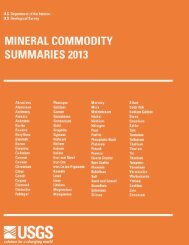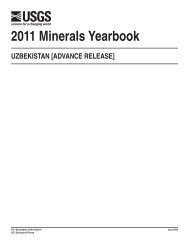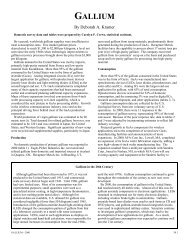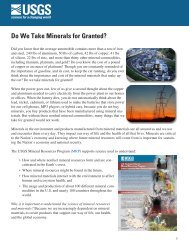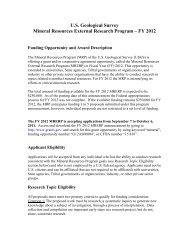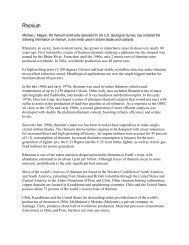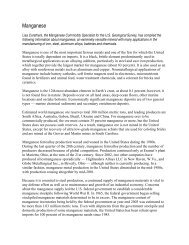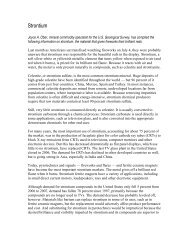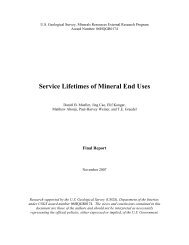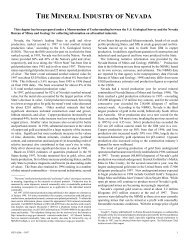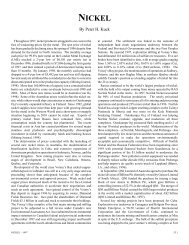Mineral Commodity Summaries 2003 - Mineral Resources Program ...
Mineral Commodity Summaries 2003 - Mineral Resources Program ...
Mineral Commodity Summaries 2003 - Mineral Resources Program ...
You also want an ePaper? Increase the reach of your titles
YUMPU automatically turns print PDFs into web optimized ePapers that Google loves.
92<br />
IRON AND STEEL SLAG<br />
(Data in thousand metric tons, unless otherwise noted)<br />
Domestic Production and Use: Ferrous slags are valuable coproducts of ironmaking and steelmaking. In 2001,<br />
about 19 million tons of domestic iron and steel slag, valued at about $165 million 1 (f.o.b.), were consumed. Iron or<br />
blast furnace slag accounted for about 65% of the tonnage sold and was worth about $127 million. Steel slag,<br />
produced from basic oxygen, electric arc, and open hearth furnaces 2 accounted for the remainder. There were 18<br />
slag-processing companies servicing either iron and steel or just steel facilities at about 100 locations, iron slag at<br />
about 30 sites in a dozen States, and steel slag at about 90 sites in about 30 States. The north-central region (Illinois,<br />
Indiana, Michigan, and Ohio) accounted for 58% of blast furnace slag sold or used in the United States, and the mid-<br />
Atlantic region (Maryland, New York, Pennsylvania, and West Virginia) accounted for 30% of the sales.<br />
The major uses of iron slag were for road bases, 33%; asphaltic aggregates 23%; cement and concrete applications,<br />
22%; and fill, 7%. Steel slags were mainly used for road bases, 37%; fill, 22%; and asphaltic aggregates, 22%. About<br />
79% of iron and steel slag shipments was by truck, generally to customers within approximately 80 kilometers of the<br />
plant. Waterway and rail transport accounted for about 15% and 6% of shipments, respectively; these shipments were<br />
to more distant markets.<br />
Salient Statistics—United States: 1998 1999 2000 2001 2002 e<br />
Production, marketed 3<br />
18,400 17,000 16,300 16,900 16,500<br />
Imports for consumption 700 920 1,200 2,600 2,500<br />
Exports 10 12 20 ( 4 ) ( 4 )<br />
Consumption, apparent 5<br />
19,000 18,000 20,200 19,500 19,000<br />
Price average value, dollars per ton, f.o.b. plant 8.00 8.80 8.60 8.05 8.10<br />
Stocks, yearend NA NA NA NA NA<br />
Employment, number e<br />
Net import reliance<br />
2,700 2,750 2,750 2,700 2,700<br />
6 as a percentage of<br />
apparent consumption 4 5 10 8 6<br />
Recycling: Ferrous slags are viewed as valuable byproducts of ironmaking and steelmaking. Apart from the large<br />
outside markets for slag in the construction sector, some iron and steel slags are used in the furnaces as ferrous and<br />
flux feed. Entrained metal, particularly in steel slag, is routinely recovered during slag processing for return to the<br />
furnaces. However, data for such furnace feed uses are unavailable.<br />
Import Sources (1998-2001): Year-to-year import data for ferrous slags show variations in both tonnage and unit<br />
value; most of the data contain unresolved discrepancies. Slag was imported from 1998 to 2001 mainly from Italy,<br />
Japan, Canada, and Brazil; prior sources were mainly Canada and Japan. Data, estimated for 2002 only, are Italy,<br />
37%; Japan, 27%; Canada, 14%; and other, 22%.<br />
Tariff: Item Number Normal Trade Relations<br />
12/31/02<br />
Granulated slag 2618.00.0000 Free.<br />
Basic slag 3103.20.0000 Free.<br />
Ferrous scale 2619.00.9000 Free.<br />
Slag, dross, scalings, from<br />
manufacture of iron and steel 2619.00.3000 Free.<br />
Depletion Allowance: Not applicable.<br />
Government Stockpile: None.<br />
Prepared by Rustu S. Kalyoncu [(703) 648-7720, rkalyonc@usgs.gov, fax: (703) 648-7722]



